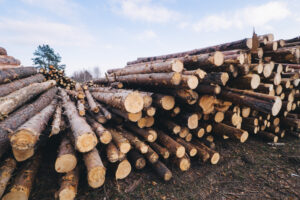National Forest Products Week – October 18 – 24
[bs_row class=”row”]
[bs_col class=”col-sm-12″]
 Last month National Forest Products Week was held. According to Senators Boozman from Arkansas and Stabenow from Michigan, the industry employs 900,000 people and creates almost $240 billion in economic output annually. Also, the National Wood Flooring Association states that although industry volume has doubled over the last century, the country’s forestland has remained stable at 755 million acres. These statistics show that even though slightly more than half of US forestland is privately owned, these landowners practice good management and stewardship of their forests.
Last month National Forest Products Week was held. According to Senators Boozman from Arkansas and Stabenow from Michigan, the industry employs 900,000 people and creates almost $240 billion in economic output annually. Also, the National Wood Flooring Association states that although industry volume has doubled over the last century, the country’s forestland has remained stable at 755 million acres. These statistics show that even though slightly more than half of US forestland is privately owned, these landowners practice good management and stewardship of their forests.
The following is courtesy of an article from Pallet Enterprise by Lisa Monroe:
There are no shortage of myths and exaggerations about how the forest and wood products industry affects the forests and the environment in the United States. And sometimes it is hard to know how to respond when confronted with such negative statements. You know that they’re not all true, but how do you defend yourself?
Well, we’ve put together some useful facts and quotes below that might help the next time you’re confronted with a negative statement about the forest and wood products industry. These can be useful also when asked questions about the industry, or in conversations in general.
The source for each fact or quote is cited with a reference number at the end, and a key to these sources is provided at the bottom of the article.
Is Logging Bad for the Forests?
- “Can logging help fight climate change? Surprisingly, it can — if done in a sustainable way. Reduced-impact logging — logging that ensures only the trees needed for commercial use are felled — can reduce carbon emissions from logging by up to 30%.”1
- Logging companies pay a special fee for replanting and reforestation when they buy the right to harvest timber on state or national forests.2
- Forest certification by the Forest Stewardship Council (FSC) was launched over a decade ago to help protect forests from destructive logging practices. Like the “organically grown” sticker on produce, forest certification was intended as a seal of approval — a means of notifying consumers that a wood or paper product comes from forests managed in accordance with strict environmental and social standards.10 (Add SFI and Tree Forest certification data)
- 38,831,376 acres of forest land in the United States is certified by the FSC.11
- “In the United States, much of our forestland is private. If landowners can’t earn a living from these forests, they will inevitably cut them down for farms, ranches or real estate development. While total acreage of forests in the United States remains relatively stable, certain parts of the country are seeing declining forest coverage. For example, the U.S. Forest Service estimates 12 million acres of forest in the Southeast will be lost to suburban real estate development between 1992 – 2020.11
Aren’t we Running Out of Forests in the United States?
- Because the United States practices reforestation, its forests have actually grown in size over the past century. About one-third of the United States — 747 million acres — is covered with trees. In fact, we have more trees today than we had 70 years ago.2
- In the United States, four million more trees are planted each day. 2
- On the nation’s commercial forests, net annual growth exceeds harvests and losses to insects and disease by an impressive 47% each year. 2
- The United States has about 751.2 million acres of forest land.6
- Commercial timberland can be used for repeated growing and harvesting of trees.7
- Forests that are responsibly managed protect biodiversity and water quality, while also replanting and reforesting the areas being harvested.8
- The United States ranks fourth on the list of most forest-rich countries, following the Russian Federation, Brazil, and Canada, with 8% of the world’s primary forest.9
- Forests cover 30% of global land area.11
I Heard that Using Wooden Products Is Bad for Forests and the Environment. Is that True?
- Countries with large steady quantities of industrial wood use are more likely to maintain their forest base.3
- Forest managers and land owners can recover management costs from revenues generated by selling wood. This will incentivize forest land owners to maintain their forest base and prevent them from converting forest land to other use.3
- “The biggest driver of deforestation is agriculture. Farmers cut forests to provide more room for planting crops or grazing livestock.”4
- Forest management and sustainable forestry practices have evolved and expanded to include the manufacture of wood products from small-diameter trees, dead trees or brush.3
- A recent lifecycle analysis found that harvesting, transporting, manufacturing, and using wood in lumber and panel products in building yields fewer air emissions–including greenhouse gases–than the resource extraction, manufacture and use of other common building materials.3
- Wood is better for the environment in terms of greenhouse gas emissions, air and water pollution, and other impacts. Steel and concrete consume 12% and 20% more energy, emit 15% and 29% more greenhouse gases and release 10% and 12% more pollutants into the air, and generate 300% and 225% more water pollutants than wood.5
- Wood products store carbon, helping to mitigate climate change while also providing a good alternative for materials that require large amounts of fossil fuels to produce. 5
- Using wood helps to sustain our forests and increases our carbon storage potential by helping to ensure that it
is affordable for forest owners to continue sustainably managing their forestland. 5
- Forest products companies are in the business of growing and harvesting trees, so reforestation is important to them. In fact, more than 91% of all trees planted in America during 1999 were planted by forest product companies and private timberland owners. 2
- Trees are a renewable resource. Most alternative materials come from nonrenewable resources, such as the petrochemicals used in making plastics and the ores used to make aluminum, iron and other metals. 2
- Steel wall studs require almost nine times more energy to produce than do wood studs. A brick veneer wall requires 22 times more energy than wood siding, while aluminum siding requires 21 times more energy to produce than does an equivalent wood floor. 2
- “Sustainable forest management, which is the practice of planting new trees while cutting down other trees, is key to balancing the demands for forest products while preserving the health and diversity of forests. Products and resources that are sustainably developed meet the current needs of humans while preserving the environment for future generations.”8
- The Nature Conservancy
- Virginia’s Sustainable Forestry Initiative Program
- USDA Forest Service
- National Geographic
- American Forest Foundation
- U.S. Census Bureau, Statistical Abstract of the United States: 2012; 2007 data.
- Environmental Protection Agency
- American Forests
- Society of American Foresters
- Natural Resources Defense Council
- Forest Stewardship Council
[/bs_col]
[/bs_row]
